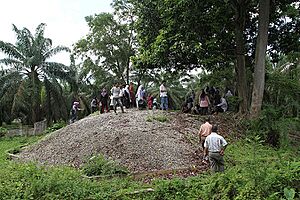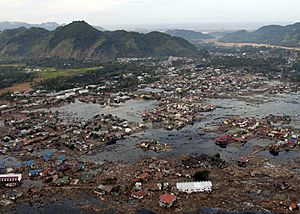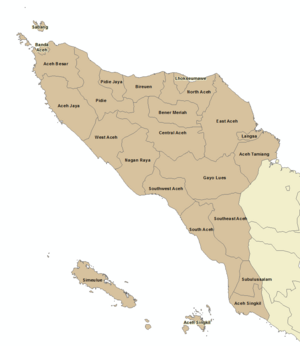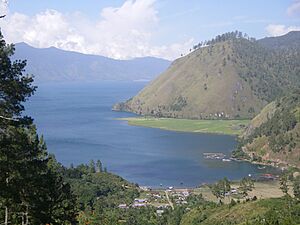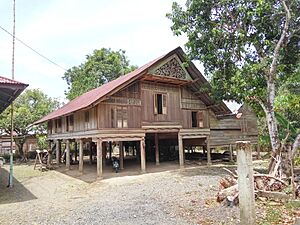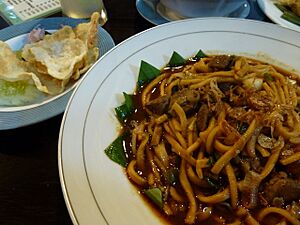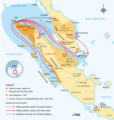Aceh, Indonesia facts for kids
Quick facts for kids
Aceh
|
|||
|---|---|---|---|
| Province of Aceh | |||
|
|||
| Nickname(s): | |||
| Motto(s):
Pancacita (Kawi)
"Five Ideals" |
|||
| Anthem: Aceh Mulia "Noble Aceh" |
|||
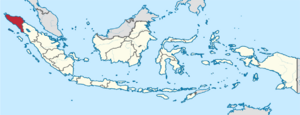
|
|||
|
OpenStreetMap
|
|||
| Country | Indonesia | ||
| Province status | 7 December 1956 | ||
| Capital and largest city |
Banda Aceh | ||
| Government | |||
| • Type | Special autonomous province | ||
| Area | |||
| • Total | 58,485.9 km2 (22,581.5 sq mi) | ||
| Area rank | 11th | ||
| Elevation | 125 m (410 ft) | ||
| Highest elevation
(Mount Leuser)
|
3,466 m (11,371 ft) | ||
| Lowest elevation | 0 m (0 ft) | ||
| Population
(2023)
|
|||
| • Total | 5,512,219 | ||
| • Rank | 14th | ||
| • Density | 94.24868/km2 (244.10297/sq mi) | ||
| • Density rank | 20th | ||
| Demonym(s) | Acehnese | ||
| Demographics | |||
| • Ethnic groups | |||
| • Religion |
|
||
| • Languages |
|
||
| Time zone | UTC+7 (Indonesia Western Time) | ||
| GDP (nominal) | 2022 | ||
| - Total | Rp 211.8 trillion (20th) US$ 14.3 billion Int$ 44.5 billion (PPP) |
||
| - Per capita | Rp 39.2 million (30th) US$ 2,637 Int$ 8,229 (PPP) |
||
| - Growth | |||
| HDI | |||
Aceh is a special province located at the very western tip of Sumatra island in Indonesia. Its capital and largest city is Banda Aceh. Aceh is unique because it has a special self-governing status. It is the only Indonesian province that officially follows Sharia law, which is a set of religious laws based on Islamic teachings.
Aceh is famous for being the place where Islam first spread in Indonesia and then across Southeast Asia. In the 1600s, the Sultanate of Aceh was a very rich and powerful kingdom. The people of Aceh have a long history of wanting to be independent and resisting control from outside, including from the Dutch colonists and later the Indonesian government.
This province also has lots of natural resources like oil and natural gas. In 2004, Aceh was hit very hard by a massive tsunami. This terrible disaster led to a peace agreement between the Indonesian government and a group that wanted Aceh to be separate, called the Free Aceh Movement.
Contents
Exploring Aceh's Past
Early History: Ancient Times
Archaeologists have found signs of the first people living in Aceh a very long time ago. Near the Tamiang River, they found piles of shells and old Stone tools. Experts believe people lived there around 10,000 BCE, which is over 12,000 years ago!
Before Islam arrived, there were Hindu-Buddhist cultures in Aceh. For example, the people of the Lambri Kingdom were described as "idolaters" by Marco Polo, meaning they likely followed Hindu or Buddhist beliefs.
How Islam Came to Southeast Asia
Historians believe that Aceh was one of the first places in Southeast Asia where Islam became important. When Venetian traveler Marco Polo visited Sumatra in 1292, he noted that the town of Peureulak was Muslim. Later, in 1297, the tombstone of Sultan Malik as-Salih, the first Muslim ruler of Samudra, was found. This is the earliest clear proof of a Muslim kingdom in the Indonesia-Malay area.
By the 1400s, Islam had spread along Aceh's coast. Aceh then became a major center for Islamic learning and culture in Southeast Asia. It also became very rich because it was a busy trading hub.
The Powerful Aceh Sultanate
The Sultanate of Aceh was founded in 1511 by Sultan Ali Mughayat Syah. This kingdom grew very strong in the 1600s. Its power reached as far as southern Thailand and parts of the Malay Peninsula.
When the Portuguese took over Malacca in 1511, many Muslim traders moved their business to Banda Aceh. This made the Acehnese rulers even wealthier. During the time of Sultan Iskandar Muda in the 17th century, Aceh was very influential. Aceh even teamed up with the Ottoman Empire and the Dutch East India Company to fight against the Portuguese.
Over time, Aceh's military power became weaker. By the early 1800s, Aceh became important again because of its location for trade. It produced more than half of the world's black pepper!
The Aceh War: Fighting for Freedom
In 1873, the Dutch colonial government declared war on Aceh. The Dutch wanted to control Aceh, but the Acehnese people fought back fiercely. This war lasted for four decades and was a long and difficult guerrilla war. The Acehnese army even killed the Dutch commander, General Köhler. The war was very expensive for the Dutch and caused a lot of suffering.
Japanese Occupation During World War II
During World War II, Japanese troops took control of Aceh. The Acehnese ulama (Islamic religious leaders) fought against both the Dutch and the Japanese. They rebelled against the Dutch in 1942 and against Japan later that year. These revolts showed the strong spirit of the Acehnese people.
Becoming Part of Indonesia
After World War II, a civil war broke out in Aceh in 1945. This was between groups who wanted the Dutch to return and religious leaders who supported the new country of Indonesia. The religious leaders won, and Aceh remained free during Indonesia's fight for independence. The Dutch military never managed to invade Aceh.
The Free Aceh Movement and Peace
After Aceh joined independent Indonesia, some Acehnese felt their rights were not respected. In the 1950s, a rebellion started, led by Daud Beureu'eh. The Indonesian government tried to calm things down by giving Aceh more freedom in religion, education, and culture.
Later, in the 1970s, a group called the Free Aceh Movement (GAM) began fighting for Aceh's independence. They felt that Aceh's natural resources were not benefiting the local people enough. This conflict lasted for many years, with a lot of hardship for the Acehnese people.
The 2004 Tsunami Disaster
On December 26, 2004, a huge tsunami hit the western coast of Aceh. Cities like Banda Aceh, Calang, and Meulaboh were devastated. Over 170,000 people in Aceh were killed or went missing, and about 500,000 lost their homes. It was a truly terrible event.
This disaster, however, helped bring about peace. The Indonesian government and the Free Aceh Movement signed a peace agreement in 2005. This agreement gave Aceh special self-governing rights, and the rebel group agreed to disarm. The tsunami also led to a stronger focus on religious practices in Aceh.
After the tsunami, a huge effort began to rebuild Aceh. Many international organizations and people helped. The Indonesian government set up a special agency to manage the reconstruction. While progress was slow due to the massive scale of the damage, new homes and buildings were gradually put up. A museum was opened in 2009 to remember the tsunami, with photos and stories.
Nature and Wildlife in Aceh
Aceh is home to an amazing variety of plants and animals. It has some rare large mammals like the Sumatran rhinoceros, Sumatran tiger, Orangutan, and Sumatran elephant. Sadly, Aceh has faced a lot of deforestation since the 1970s, which threatens these animals and their homes.
How Aceh is Governed
Aceh is a special autonomous province in Indonesia. This means it has more freedom to make its own rules compared to other provinces. For example, Aceh has the right to apply Sharia law more widely.
The province holds elections for its leaders. In 2006, Irwandi Yusuf became governor, and in 2012, Zaini Abdullah was elected governor.
Laws in Aceh

Aceh has special local laws called qanuns that are based on Sharia. These laws cover things like religious practices and public behavior. There is also a special Sharia police force called the Wilayatul Hisbah that helps enforce these laws.
Parts of Aceh: Cities and Regions
Aceh is divided into 18 regencies (like counties) and 5 cities. The capital city is Banda Aceh. Over the years, new regencies and cities have been created to help manage the area better.
Aceh also has a unique system of grouping its villages into mukims. These are traditional communities. Recently, the Indonesian government has started to recognize the rights of some mukims over their traditional forests.
Aceh's Economy
After the 2004 tsunami, Aceh's economy grew a lot, especially in construction, as the province was rebuilt. The peace agreement also helped the economy.
The economy has changed quite a bit. Service industries, like tourism and banking, have become more important. The share of oil and gas in the economy has gone down.
Even though the economy has grown, the cost of living in Aceh is still higher than in other parts of Indonesia. Poverty levels in Aceh are also higher than the national average, so there's still a need for more development.
People and Culture of Aceh
Aceh has a diverse population with many different ethnic and language groups. The largest group is the Acehnese people. Other groups include the Gayo people, Alas people, Tamiang-Malays, and Aneuk Jamee people. There are also people of Chinese, Arab, Turkish, and Indian descent.
Languages Spoken
The Acehnese language is widely spoken. It's related to languages found in Vietnam and Cambodia, and also to Malay. Acehnese has many words borrowed from Malay and Arabic. It is also an official regional language alongside Indonesian. Other languages spoken include Alas, Kluet, and Jamee.
Religion in Aceh
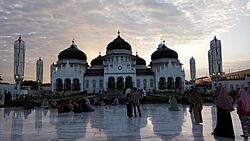
Aceh is mostly Muslim, with over 98% of the population following Islam. Religious matters are very important in Aceh. While other religious groups exist, they sometimes feel pressure to limit their activities. For example, some churches have been ordered to close because they didn't have the right permits.
Traditional Culture of Aceh
Aceh has a rich and unique culture, with special arts and traditions.
Traditional Weapons
- The Rencong is a traditional dagger, a very important weapon for the Acehnese people. Its shape looks like the letter L, and if you look closely, it resembles Arabic calligraphy for "bismillah."
- Other traditional weapons include the sikin panyang, peurise awe, and siwah.
Traditional Houses
The traditional house in Aceh is called Rumoh Aceh. These houses are built on stilts and have three main parts: a front porch, a middle porch, and a back porch. There's also usually a separate kitchen house.
Dances
Acehnese traditional dances tell stories about their heritage, religion, and local legends. These dances are usually performed in groups, often with dancers of the same gender. Some dances are accompanied by the dancers' own voices and body percussion, while others use musical instruments. Famous Acehnese dances include the Rateb Meuseukat Dance and the Saman dance.
Food
Acehnese food uses a mix of spices from Indian and Arabic cooking, like ginger, pepper, coriander, and cinnamon. Many dishes are cooked with curry spices and coconut milk, often with meat like buffalo, beef, or chicken. Popular Acehnese foods include nasi gurih, mie aceh, and timphan.
Literature
Aceh has a long tradition of oral literature, like the folktale The king of the parakeets. Most old Acehnese literature was in the form of poetry called Hikayat. Prose writing became more common after the Dutch arrived in the 1930s.
Getting Around Aceh
Aceh is building new roads, like the Sigli–Banda Aceh Toll Road, which is part of a larger road network across Sumatra.
Railways in Aceh started during the Dutch colonial era. Today, there's a train called Cut Meutia that serves some areas in North Aceh.
For air travel, Aceh has airports like Sultan Iskandar Muda International Airport near Banda Aceh and Maimun Saleh Airport in Sabang.
See Also
 In Spanish: Provincia de Aceh para niños
In Spanish: Provincia de Aceh para niños
- List of people from Aceh
- Acehnese local government system
Images for kids
-
Head of Avalokiteshvara from Aceh.




